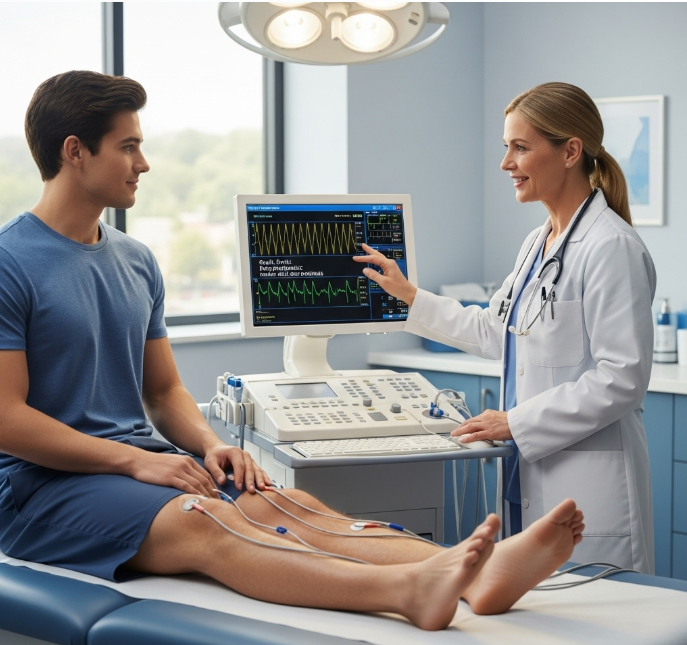Electromyography (EMG) is a powerful diagnostic tool, a cornerstone in assessing the health of muscles and
the nerve cells that control them. It plays a crucial role in diagnosing and managing neuromuscular conditions.
Muscular Dystrophy (MD), a group of genetic diseases, presents significant challenges, causing progressive
muscle weakness and loss of muscle mass. These challenges often manifest as difficulties with mobility,
performing daily tasks, and participating in social activities, significantly impacting overall well-being and quality
of life. This blog explores how different ways EMG enhances physiotherapy and empowers individuals living with MD.
Understanding EMG's Role in Muscular Dystrophy Management
EMG helps diagnose muscle diseases, including MD, by measuring the electrical activity of muscles and providing
insights into their function and the nerves that control them. It can differentiate between muscle disorders and
nerve-related issues. For instance, in muscle disorders, the electrical signals might show abnormal patterns
of muscle fiber activity, while nerve-related issues might reveal slowed nerve conduction speeds. Along with
nerve conduction studies, EMG assesses the speed and strength of nerve signals. The procedure involves
inserting small needles into specific muscles to record their electrical activity during rest and contraction. This
data helps physiotherapists and physicians understand the extent and nature of muscle involvement, leading to
more effective and personalized care plans. The potential discomfort associated with the procedure is managed
to ensure patient comfort. For example, EMG is helpful for diagnosing the causes of unexplained muscle pain
and weakness.
Early and Accurate MD Diagnosis with EMG
One of the most significant benefits of EMG is its ability to aid in early and accurate diagnosis of MD. Because
MD encompasses a range of genetic disorders with varying presentations, early detection is crucial for timely
intervention. Early diagnosis is essential for managing the disease effectively. EMG can help identify the specific
muscles affected, which is crucial for targeted interventions. EMG can differentiate between various types of
MD and other neuromuscular disorders. By identifying patterns of muscle weakness and electrical activity, EMG
helps clinicians distinguish MD from other conditions with similar symptoms. This accurate diagnosis allows for
the implementation of appropriate management strategies and genetic counseling. Genetic counseling can help
families understand the inheritance patterns of MD and make informed decisions about family planning.
EMG: Monitoring Subtle Changes for Early MD Intervention
Muscular Dystrophy is a progressive condition, meaning muscle weakness worsens over time. EMG detects early
signs of muscle weakness, enabling proactive management. Through regular assessments, we can track the
progression, pinpointing specific muscles that need immediate attention. The frequency of EMG assessments
is determined based on the individual patient's needs and disease progression. This information allows phys-
iotherapists to adapt exercise programs and other interventions to address the changing needs of the patient,
maximizing their functional abilities and slowing down the disease's impact. Early diagnosis is crucial for timely
intervention and effective management. Specific exercises might be used to target specific muscle weaknesses.
EMG Guiding Personalized Physiotherapy for MD
EMG findings empower us to craft truly personalized exercise programs. For example, if EMG reveals weakness
in specific shoulder muscles, we can design targeted exercises to rebuild strength and improve range of
motion, rather than relying on a one-size-fits-all approach. By identifying the specific muscles that are weak or
dysfunctional, physiotherapists can design targeted exercises to strengthen those muscles and improve overall
function. This personalized approach ensures that patients receive the most effective and efficient physiotherapy
interventions, optimizing their outcomes and quality of life. Patient education is also a key component of
personalized physiotherapy, ensuring that patients understand their condition, the goals of physiotherapy, and
how to perform exercises correctly and safely. EMG is a critical diagnostic tool for evaluating the electrical activity
of muscles and nerves.
Assessing Respiratory Muscle Function to Inform Physiotherapy
in Advanced MD
In advanced stages of MD, respiratory muscle weakness can become a significant concern, leading to breathing
difficulties and increased risk of respiratory infections. EMG can assist in the evaluation of respiratory muscle
function, which is critical in advanced stages of MD. EMG can assess the strength and endurance of the
diaphragm and other respiratory muscles, providing valuable information for guiding respiratory physiotherapy
interventions. These interventions may include breathing exercises and assisted coughing techniques to improve
respiratory muscle function, and the use of respiratory support devices to maintain adequate ventilation. EMG
can also be used to monitor the effectiveness of respiratory physiotherapy interventions.
EMG-Driven Physiotherapy: Improving Quality of Life for MD
Patients
Ultimately, the goal of physiotherapy for individuals with MD is to improve their quality of life. EMG-driven
physiotherapy plays a vital role in achieving this goal by providing objective data to guide treatment decisions and
monitor progress. By using EMG to personalize exercise programs, address respiratory muscle weakness, and
track treatment outcomes, physiotherapists can help patients maintain their independence, reduce pain, and improve
their overall well-being. Physiotherapy can also provide psychological benefits, helping patients cope with the emotional
challenges of living with a chronic condition.
Conclusion
Electromyography (EMG) is a powerful tool that significantly enhances the effectiveness of physiotherapy
for individuals with Muscular Dystrophy. From early diagnosis and monitoring disease progression to guiding
personalized treatment plans and assessing respiratory muscle function, EMG provides valuable insights that
empower physiotherapists to deliver targeted and effective care. By embracing this technology, and remaining
committed to accessible, affordable, and personalized care, we can transform physiotherapy, one patient at a
time, and improve the quality of life for those living with MD.
